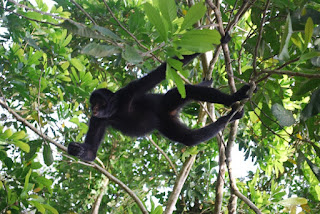
The spider monkey is one of the New World’s primitive monkeys. Spider monkeys are found in seven different species throughout Central and South America, as well as northern Mexico. Spider monkeys are found in dense, wet tropical rainforests. The number of spider monkeys is constantly decreasing due to habitat loss, intensive deforestation, hunting (indigenous people eat spider monkey meat), and pet trade. The critically endangered species include the black-headed spider monkey, woolly spider monkey, and brown spider monkey.
The size of a spider monkey varies depending on the species. Spider monkeys grow to be 13.25 pounds, 2 feet long, and 3-5 feet tall on average.
The spider monkey’s long, prehensile tail is one of its most distinguishing features. The tail serves as a fifth limb, allowing movement through dense vegetation.
Spider monkeys get their name because they hang from trees by grasping different branches with their limbs and long tails, which are “shaped” like spiders.
Spider monkeys have no thumb. Their four fingers are curved and resemble a hook, which is a unique adaptation to forest life.
Spider monkeys are arboreal animals that live in the treetops and are rarely seen on the ground.
Spider monkeys primarily consume plant-based foods. Fruit, seeds, nuts, and flowers make up 90% of their diet. Aside from that, spider monkeys consume bird eggs and insects.
Spider monkeys are highly social creatures. They live in groups known as troops. Spider monkeys will divide into smaller groups to search for food because they are diurnal (active during the day).
When different troops of spider monkeys meet, they greet each other by hugging to avoid confrontation and potential aggression.
Spider monkeys congregate in large groups and sleep in the trees at night, where they are safe from predators.
Jaguars, pumas, ocelots, and large snakes are the primary predators of spider monkeys.
Spider monkeys communicate using a variety of sounds. When threatened, they can make screams and sobbing sounds, as well as bark.
Spider monkeys have no set breeding season and can reproduce all year.
Females reach sexual maturity at the age of four, while males reach sexual maturity at the age of five, but they reproduce slowly. Every 3 to 4 years, the female produces offspring.
Pregnancy lasts 7 months and results in one child. Mother is responsible for the baby on her own. The baby will be attached to the mother’s belly for the first 4 to 5 months of her life. After that, the child will be moved to the mother’s back for the next 6 months. Two years old spider monkeys drink mother’s milk.
Spider monkeys can live in the wild for 22 to 25 years and in captivity for up to 35 years.








